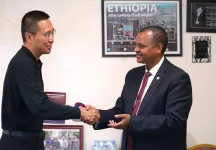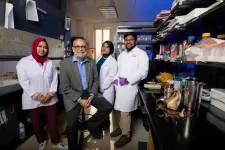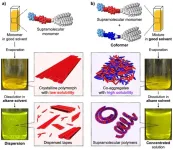Scientists take a step forward in understanding how to tackle chronic infections in cystic fibrosis patients
2023-11-21
(Press-News.org) Scientists have engineered a living material resembling human phlegm, which will help them to better understand how a certain kind of infection develops on the lungs of patients with cystic fibrosis.
The study, published in Matter, was led by Dr Yuanhao Wu and is a collaboration between Professor Alvaro Mata in the School of Pharmacy and Department of Chemical Engineering and Professor Miguel Cámara from the National Biofilms Innovation Centre in the School of Life Sciences at the University of Nottingham.
Biofilms are strong living 3D materials that play key roles in nature, but also cause major problems in the real world, such as in the contamination of hospital surfaces, or in our tolerance to antibiotic treatment.
One of the biggest challenges in antimicrobial discovery is the lack of biofilm models which reflect the complexity of natural environments, such as those encountered in the lung of cystic fibrosis (CF) patients.
Due to a genetic alteration, these patients are unable to clear infections in their lungs where complex communities of disease-causing microbes accumulate within thick mucus forming 3D biofilms. These natural biofilms are highly resilient to antibiotics and there is a critical need to develop in vitro models which can reliably reproduce them in the lab, so that experts can better understand their biology and develop solutions to the problems they cause.
This will enable a more consistent evaluation of novel therapeutic interventions before being taking into pre-clinical studies. These models will also be key to answering fundamental research questions on the interactions polymicrobial biofilms and their host which lead to chronic infections.
In this study, experts engineered a living material resembling natural sputum, or phlegm, from CF patients that can grow 3D polymicrobial biofilms in a controlled manner, resembling those found in the CF lung. The team were able to achieve this by combining peptides with a culture medium that is known to recreate natural sputum and which can be easily infected.
The living material incorporates multiple microbial communities and key nutritional and chemical factors that promote bacterial growth and exhibit physical properties mimicking those of biofilms from CF sputum. The material has been used to build an infected in vitro lung epithelial model that was used to study the impact of antibiotics.
Professor Mata says: “The capacity to create complex 3D biofilms in the lab in a simple manner, will lead to practical tools to better understand how these living structures form and how to treat them better.”
Professor Cámara says: “The technology developed in this study will revolutionise the way we study biofilm-mediated infections and assess the effectiveness of novel antimicrobials using different in vivo-like infection environments.”
The work has been supported by the National Biofilms Innovation Centre and the European Research Council proof-of-concept grant NOVACHIP.
Scientists have engineered a living material resembling human phlegm, which will help them to better understand how a certain kind of infection develops on the lungs of patients with cystic fibrosis.
The study, published in Matter, was led by Dr Yuanhao Wu and is a collaboration between Professor Alvaro Mata in the School of Pharmacy and Department of Chemical Engineering and Professor Miguel Cámara from the National Biofilms Innovation Centre in the School of Life Sciences at the University of Nottingham.
Biofilms are strong living 3D materials that play key roles in nature, but also cause major problems in the real world, such as in the contamination of hospital surfaces, or in our tolerance to antibiotic treatment.
One of the biggest challenges in antimicrobial discovery is the lack of biofilm models which reflect the complexity of natural environments, such as those encountered in the lung of cystic fibrosis (CF) patients.
Due to a genetic alteration, these patients are unable to clear infections in their lungs where complex communities of disease-causing microbes accumulate within thick mucus forming 3D biofilms. These natural biofilms are highly resilient to antibiotics and there is a critical need to develop in vitro models which can reliably reproduce them in the lab, so that experts can better understand their biology and develop solutions to the problems they cause.
This will enable a more consistent evaluation of novel therapeutic interventions before being taking into pre-clinical studies. These models will also be key to answering fundamental research questions on the interactions polymicrobial biofilms and their host which lead to chronic infections.
In this study, experts engineered a living material resembling natural sputum, or phlegm, from CF patients that can grow 3D polymicrobial biofilms in a controlled manner, resembling those found in the CF lung. The team were able to achieve this by combining peptides with a culture medium that is known to recreate natural sputum and which can be easily infected.
The living material incorporates multiple microbial communities and key nutritional and chemical factors that promote bacterial growth and exhibit physical properties mimicking those of biofilms from CF sputum. The material has been used to build an infected in vitro lung epithelial model that was used to study the impact of antibiotics.
Professor Mata says: “The capacity to create complex 3D biofilms in the lab in a simple manner, will lead to practical tools to better understand how these living structures form and how to treat them better.”
Professor Cámara says: “The technology developed in this study will revolutionise the way we study biofilm-mediated infections and assess the effectiveness of novel antimicrobials using different in vivo-like infection environments.”
The work has been supported by the National Biofilms Innovation Centre and the European Research Council proof-of-concept grant NOVACHIP.
END
ELSE PRESS RELEASES FROM THIS DATE:
2023-11-21
EMBARGOED by JAMA Network Open until 11 am, ET, Nov. 21, 2023
Contact: Gina DiGravio, 617-358-7838, ginad@bu.edu
BU Study Finds Long-term Acute Care Hospital Closures Associated with Changes in Hospital Care Practices
(Boston)—Long-term acute care hospitals (LTCHs) are common sites of post-acute care for patients recovering from severe respiratory failure requiring long-term mechanical ventilation. Because of longer lengths of stay compared to regular, short-stay hospitals, the Centers for Medicare and Medicaid (CMS) reimburses LTCHs at higher rates. However, since 2005, ...
2023-11-21
What is the mechanism that allows our brains to incorporate new information about the world, and form memories? New work by a team of neuroscientists led by Dr Tomás Ryan from Trinity College Dublin shows that learning occurs through the continuous formation of new connectivity patterns between specific engram cells in different regions of the brain.
Whether on purpose, incidentally, or simply by accident, we are constantly learning and so our brains are constantly changing. When we navigate the world, interact with each other, or consume media content, our brain is grasping ...
2023-11-21
A drug that boosts bone growth in children with the most common form of dwarfism, may also reduce their chances of sudden infant death syndrome, sleep apnoea and needing surgery, according to a new study.
The international research trial, led by Murdoch Children’s Research Institute (MCRI) and published in The Lancet Child & Adolescent Health, has showed for the first time that vosoritide treatment increases height, facial volume and the size of the foramen magnum, the hole at the base of the skull that connects the brain with the spinal cord, in children under five with achondroplasia.
MCRI is the largest vosoritide ...
2023-11-21
Zinc — cheap, abundant, environmentally friendly — may be the answer to better batteries, but there’s a major problem: Aqueous zinc ion batteries (AZIBs) cannot match lithium-ion batteries in terms of power output. To test what electrode material composition might be able to bring AZIBs up to par, a research team based in China developed two organic frameworks with the same constituents but arranged in different ways.
When put to the test, the framework with appropriate density of active sites — where the zinc ions gain electrons to recharge the ...
2023-11-21
On October 13, 2023, in Addis Ababa, Armauer Hansen Research Institute (AHRI) and BGI Genomics signed a Memorandum of Understanding to enhance the Institute's genomics and precision medicine capabilities.
The Institute got its name from the Norwegian physician, Gerhard Henrik Armauer Hansen, who first described the leprosy bacillus (Mycobacterium leprae) and joined the Ethiopian Ministry of Health in 2004. Located in Addis Ababa, it serves as a biomedical hub for the region.
BGI Genomics provides ...
2023-11-21
This study delves into the behavioral complexities of autism spectrum disorder (ASD) by introducing the rigid-autonomous phase sequence (RAPS) formation concept. RAPS are may be responsible for the cognitive, sensory-motor, and memory-related challenges faced by individuals with ASD. By uniting these insights under a single theoretical framework, this research paves the way for innovative treatments, promising a brighter future for those with ASD.
Autism spectrum disorder (ASD) is a complex neuropsychiatric condition, marked ...
2023-11-21
Success in science, technology, engineering, and mathematics (STEM) demands keeping up with the latest tools and techniques. The AI boom, for example, has made coding and data management skills integral. But going back to school isn’t an option for most scientists. Short training programs like webinars and boot camps have become a popular alternative among busy STEM professionals. However, these formats can have significant shortcomings. There’s often no guarantee attendees will leave with the skills needed to advance their careers. And they can be exclusionary, preventing learners of all abilities and circumstances from benefiting equally.
“We’ve ...
2023-11-21
EL PASO, Texas (Nov. 21, 2023) – Neurodegenerative disorders, including Alzheimer’s, Parkinson’s and Huntington’s, affect millions of people in the United States, and the cost of caring for people who live with these conditions adds up to hundreds of billions of dollars each year.
Now, researchers from The University of Texas at El Paso may potentially have found a solution in used coffee grounds — a material that is discarded from homes and businesses around the world every day.
A team led by Jyotish Kumar, a doctoral student in the Department of Chemistry and Biochemistry, and overseen by Mahesh ...
2023-11-21
Gender stereotypes harm people of both genders—and society more broadly—by steering and sometimes limiting people to behaviors, roles, and activities linked with their gender. Widely shared stereotypes include the assumption that men are more central to professional life while women are more central to domestic life. Other stereotypes link men with math and science and women with arts and liberal arts. Perhaps surprisingly, research has shown that countries with higher economic development, individualism, and gender-equality tend to also have more pronounced gender differences in several domains, ...
2023-11-21
Supramolecular polymers (SPs) are molecular assemblies composed of non-covalently bonded small molecules. They show high recyclability originating from their dynamic nature of monomer binding, which is different from covalent polymers with non-biodegradable nature. The small repeating units that form SPs, called monomers, are specifically designed to construct multiple non-covalent bonds to enhance the stability of the resulting SPs. Such monomers can be organized into structurally distinct assemblies by forming various ...
LAST 30 PRESS RELEASES:
[Press-News.org] Scientists take a step forward in understanding how to tackle chronic infections in cystic fibrosis patients





